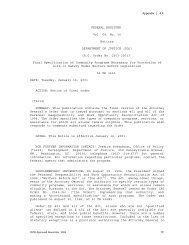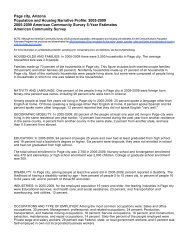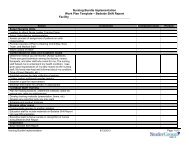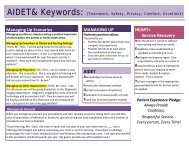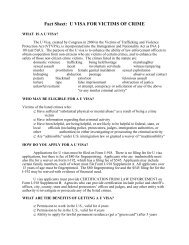4. Evaluating CHA Services
4. Evaluating CHA Services
4. Evaluating CHA Services
- No tags were found...
You also want an ePaper? Increase the reach of your titles
YUMPU automatically turns print PDFs into web optimized ePapers that Google loves.
Summary of the National Community Health Advisor Study, 1998<br />
<strong>Evaluating</strong> <strong>CHA</strong> <strong>Services</strong>: Recommendations<br />
More sensitive, practical, and inexpensive instruments for both qualitative and quantitative evaluation<br />
must be developed to monitor <strong>CHA</strong> program activities and measure program effects on clients, <strong>CHA</strong>s,<br />
communities and health care systems. Effective coordination of evaluation will allow <strong>CHA</strong> programs to<br />
continue to grow, improve, and build their credibility with funders and the communities they serve. Our<br />
recommendations for evaluation fall under two goals.<br />
Goal: Demonstrate effectiveness and improve sustainability of <strong>CHA</strong> programs by funding<br />
evaluation efforts.<br />
Recommendation 1: Make evaluation essential. Funding for <strong>CHA</strong> programs should be sufficient and<br />
should support evaluation training for <strong>CHA</strong>s and other staff. Funding periods should be long enough to<br />
allow effective program implementation and evaluation.<br />
Recommendation 2: Promote a <strong>CHA</strong> research agenda. Fund research that:<br />
a) Identifies outcomes of effective <strong>CHA</strong> programs in terms of health outcomes or access to care and<br />
links them to best practice guidelines.<br />
b) Refines and emphasizes cost/benefit analysis methodology.<br />
c) Identifies appropriate roles for <strong>CHA</strong>s in changing health care systems by examining current roles<br />
and determining the elements most effective in achieving defined outcomes.<br />
d) Identifies appropriate roles for <strong>CHA</strong>s within welfare reform.<br />
e) Conducts multi-site evaluations using a common evaluation framework and develops and tests<br />
measurement instruments for reliability and validity.<br />
Goal: Simplify and generalize <strong>CHA</strong> program evaluation methods.<br />
Recommendation 3: Develop <strong>CHA</strong> evaluation guidelines and tools. Fund, refine, and disseminate<br />
the Study’s evaluation framework along with culturally and linguistically appropriate training materials<br />
and tools to <strong>CHA</strong> practitioners.<br />
Recommendation 4: Create a <strong>CHA</strong> evaluation database. Create and maintain a database on<br />
evaluation topics such as <strong>CHA</strong> evaluation instruments, program results, and a directory of experienced<br />
<strong>CHA</strong> evaluators and practitioners who could mentor others.<br />
Recommendation 5: Recognize <strong>CHA</strong>s as partners in <strong>CHA</strong> program evaluation. <strong>CHA</strong>s, other<br />
program staff, and community members should be equal partners in the design, implementation, analysis,<br />
and dissemination of program evaluations.<br />
Evaluation Framework<br />
The Study’s <strong>CHA</strong> program evaluation framework summarized on the following two pages offers a<br />
menu of evaluation options from which individual programs can choose.<br />
22



